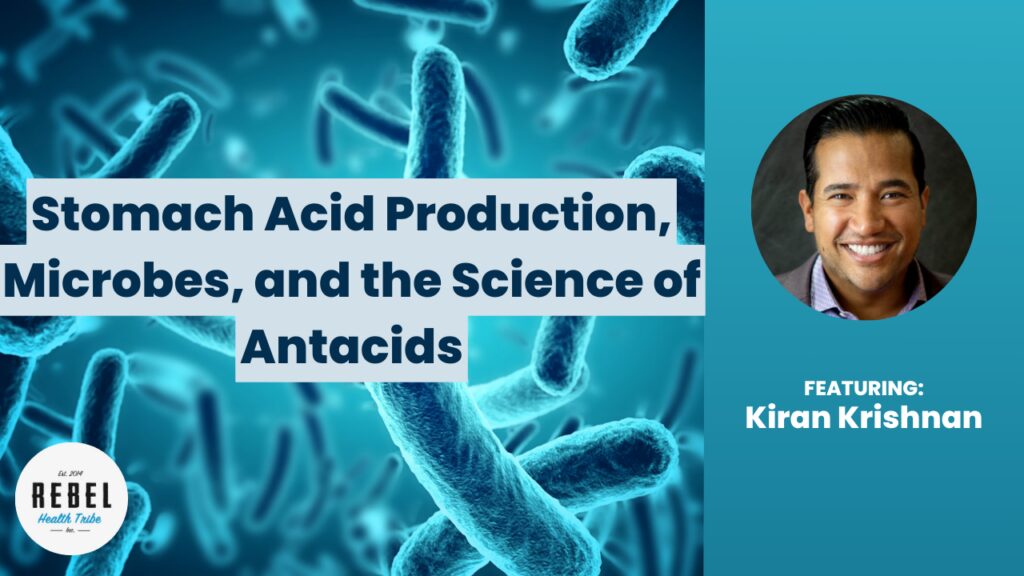
Play Video
Stomach Acid Production, Microbes, and the Science of Antacids
View the full webinar – Acid Reflux, H. Pylori, Ulcers & Upper GI Solutions with Kiran Krishnan [Part 1]
Webinar Transcript
Kiran Krishnan:
Yeah. First and foremost, it’s really important to note that acid reflux, GERD, and all that has absolutely nothing to do with an overproduction of acid, so it’s not excessive acid secretion. The whole mentality behind treating it with lowering acid and neutralizing acid, which is what the Tums and all does, is absolutely the wrong approach. What’s happening is there’s something called intraabdominal pressure, gas pressure that actually occurs within the abdomen and also within the proximal part of the small bowel, so the duodenum area.
Basically, the gas pressure forces things back up versus things moving down through peristaltic activity and through the action of gravity. The way it’s all supposed to work is you eat food that just the action of chewing itself will start to release stomach acid in preparation for the food to come into the stomach. When the bolus of food enters the stomach it’s coated with stomach acid and pepsin and a few other things, but that stomach acid in particular starts hydrolyzing things, meaning it starts breaking down things like protein, carbohydrates. It doesn’t do a whole lot to fat, but protein and carbohydrates in particular are two really important things.
The other thing that the stomach acid does is it starts to kill of bacteria that’s coming in with the food. If you imagine our ancestors, they were eating very, very microbial-rich foods because a lot of the times they were eating raw things and things that they just, animal carcasses and things like that where they were loaded potentially with pathogens as well. So when you’re consuming food that’s rich in microbes, you need an acid wash, if you will, to bring down the microbial load of the food that’s coming in so that you reduce your risk of developing pathogen-like infections from food contaminants. So stomach acid also works in that perspective.
It’s really important to start the process of breaking down food. It’s really important to act as what a lot of immunologists call your first phase of your immune system, which is the gastric barrier. Now you’ve got a low pH, things are starting to churn up. Your stomach actually has this what we call in the laboratory stomaching action, which actually smushes things up so it’s mixing things with fluid and acid and pepsin, and then that mush gets squeezed into your duodenum, where there is more acid coming out, and those acids actually help your pancreatic enzymes come in and start chopping up your food, which includes proteins, carbohydrates, and so on. That starts a process of digestion and absorption.
That aspect is really important. Now, the other feature of this section of your gut, you stomach and your proximal part of your bowel, is that the microbial load is really low. There are microbes there. There’s very specific types of microbes there, but the overall microbial load is very low. For example, typically it’s 10 to the 4 CFUs per milliliter of extract if you take out, so 10 to the 4 is a thousand colony-forming units per milliliter. Compare that to your large bowel, your colon area, that has 10 to the 11, 10 to the 12, 10 to the 14, so these are a hundred billion, a trillion CFUs per ml. So a thousand versus a trillion or a thousand versus a hundred billion CFUs per ml, that’s the difference in microbial load in these two segments.
One of the biggest things that maintains that low microbial activity in the stomach region and in the small bowel starting with the duodenum on down is the stomach acid. That acidic environment acts as a strong antimicrobial. It allows for certain bacteria to do all right in that area, but it maintains low levels. Now, if we start stopping that issue, so number one, if we reduce the amount of acid that’s being produced, we increase the pH. When we increase the pH we get two factors. One, poor digestion of the food. Number two, we increase microbial growth both in the stomach and in the small intestine, especially the proximal part of the small intestine itself.
Now, what can happen is as you start to increase microbial growth and you start to have more undigested food, because the stomach acid’s not breaking down the food as effectively, you start to select for bacteria that can digest that food in the small bowel, especially in the proximal small bowel as far up as the duodenum.
Michael Roesslein:
Where it’s not supposed to be happening.
Kiran Krishnan:
Where it’s not supposed to be happening at all. We don’t want any of that to happen. That’s part of the reason physiologically we have a naturally very low amount of bacteria in that area. Now, when you start getting any sort of fermentation going on in the duodenum itself, these fermented bacteria, especially the ones that are fermenting the amino acids that are coming in the protein through the diet, are going to be producing things like ammonia and hydrogen gas. That production of ammonia hydrogen gas causes a distention in the small intestine and the small intestine is not designed to be like the stomach, that can distend significantly beyond its normal physiological structure. It’s got a rate limited step in terms of how big the volume can be.
Once it reaches that rate limiting step because of the gas, the gas starts creating inflammation in the lining of the small intestine as well. That in itself can add to the distention. Then that distention forces its way back up, which is through the pyloric valve which separates the small intestine from the stomach, and then gas takes acid and other components back up through the stomach and then back into the esophagus as well. That’s where we experience the reflux. So this simple intraabdominal pressure that’s create by dysfunctional fermentation in the proximal part of the small intestine, which is driven by low acid, poor digestion, and an overgrowth of fermenting bacteria, typically proteolytic fermenting bacteria in those regions, will drive this reflux condition.
Now, a lot of this could have been started by an antibiotic or other behaviors, like smoking, for example, excessive drinking. These things have been shown to create dysfunction in acid secretion and oxidative stress damage to the pumps that pump out acid and so on. Lifestyle can disrupt acid production. Lack of vagal stimulation, that’s another important thing to up regulate acid production. Lifestyle components will disrupt acid production. Low acid production will lead to an overgrowth of microbes in those areas in the proximal part of the small intestine where they should be. That overgrowth causes gas pressure to create intraabdominal pressure and push stuff back up. So then what do we do to treat that? We take more antacids or we go all the way to PPIs, which brings down the acid even more, and it perpetuates the problem further.
Then you’ve got more complications, which we’ll talk about later, which is more gastroesophageal reflux and bile reflux as well, which stems from the lower part of the small intestine. We’ll talk about how that’s driven as well.

Kiran Krishnan
About our Guest
Kiran Krishnan is a Research Microbiologist and has been involved in the dietary supplement and nutrition market for the past 17 years. He comes from a strict research background having spent several years with hands-on R&D in the fields of molecular medicine and microbiology at the University of Iowa. He left University research to take a position as the U.S. Business Development and Product Development lead for Amano Enzyme, USA. Amano is one of the world’s largest suppliers of therapeutic enzymes used in the dietary supplement and pharmaceutical industries in North America. Kiran also established a Clinical Research Organization where he designed and conducted dozens of human clinical trials in human nutrition.
Kiran is also a co-founder and partner in Nu Science Trading, LLC.; a nutritional technology development, research and marketing company in the U.S. Dietary Supplement and Medical Food markets. Most recently, Kiran is acting as the Chief Scientific Officer at Physician’s Exclusive, LLC. and Microbiome Labs. He has developed over 50 private label nutritional products for small to large brands in the global market. He is a frequent lecturer on the Human Microbiome at Medical and Nutrition Conferences. He conducts the popular monthly Microbiome Series Webinars through the Rebel Health Tribe Group practitioner training program, is an expert guest on National Radio and Satellite radio and has been a guest speaker on several Health Summits as a microbiome expert. He is currently involved in 9 novel human clinical trials on probiotics and the human microbiome.
Kiran is also on the Scientific Advisory Board for 5 other companies in the industry. Kiran offers his extensive knowledge and practical application of the latest science on the human microbiome as it relates to health and wellness.






